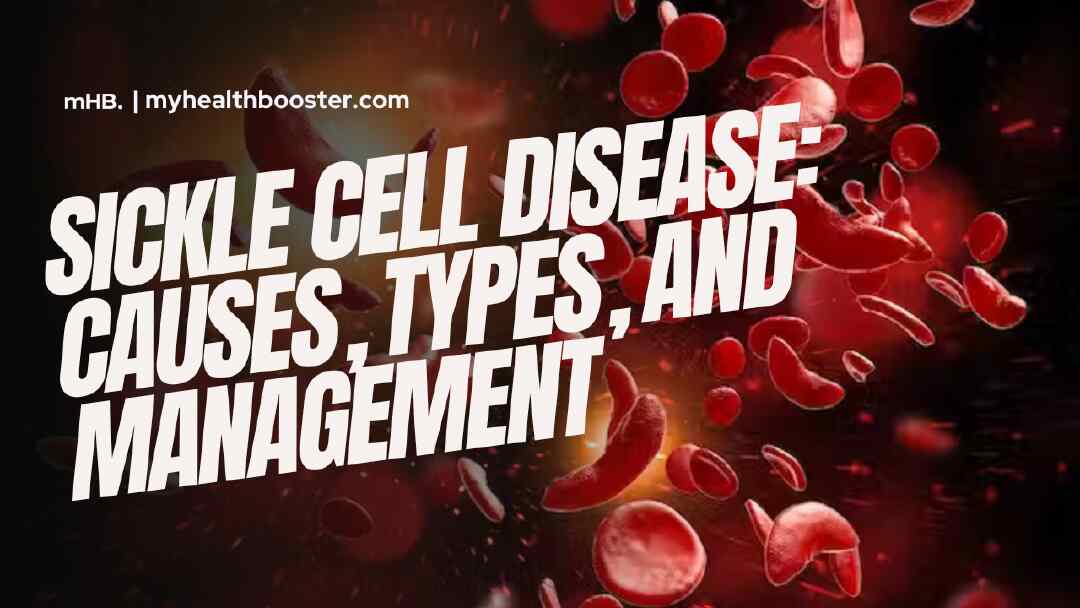Introduction
Sickle cell disease (SCD) is a group of inherited blood disorders characterized by abnormal hemoglobin, a protein that carries oxygen. In SCD, this abnormal hemoglobin causes red blood cells to become rigid and assume a sickle or C-shaped form. These altered cells lead to various complications, including pain, infections, acute chest syndrome, and strokes. This article explores the types of SCD, its causes, diagnosis, complications, and management strategies.
Types of SCD
The type of SCD a person has depends on the specific genes inherited from their parents. The most common types include:
- HbSS (Sickle Cell Anemia): Individuals with HbSS inherit two abnormal hemoglobin “S” genes, one from each parent. This results in the most severe form of SCD, characterized by rigid, sickle-shaped red cells.
- HbSC: People with HbSC inherit one hemoglobin “S” gene and another for a different abnormal hemoglobin type called “C.” This form is generally milder than HbSS.
- HbS Beta Thalassemia: This form involves one hemoglobin “S” gene from one parent and a gene for beta thalassemia (another hemoglobin abnormality) from the other parent. It comes in two types: “zero” (HbS Beta0) and “plus” (HbS Beta+). HbS Beta0-thalassemia is severe, while HbS Beta+-thalassemia tends to be milder.
There are also rare types of SCD, including HbSD, HbSE, and HbSO, which involve different combinations of abnormal hemoglobin genes.
Sickle Cell Trait (SCT)
People with SCT inherit one hemoglobin “S” gene from one parent and a normal gene (hemoglobin “A”) from the other. SCT usually doesn’t show symptoms but can occasionally lead to health issues, especially under certain conditions.
Causes of SCD
SCD is a genetic condition present at birth, resulting from inheriting two abnormal hemoglobin genes, one from each parent. These genes provide instructions for the production of abnormal hemoglobin.
Diagnosis
SCD is diagnosed through a simple blood test. In the United States, it’s often detected during routine newborn screening tests at birth. Diagnostic tests can also be performed while the baby is still in the womb using procedures like chorionic villus sampling and amniocentesis. Early diagnosis is crucial due to the increased risk of infection and other health problems in children with SCD.
Complications
Symptoms and complications of SCD vary from mild to severe, with some individuals experiencing them as early as five months of age. Complications include pain crises, infections, stroke, and acute chest syndrome, among others.
Prevention and Treatment of SCD Complications
Prevention Strategies
- Lifestyle Behaviors: People with SCD can take several steps to prevent pain crises, such as staying hydrated, avoiding extreme temperatures, and minimizing high-altitude exposure.
- Preventing Infections: Frequent handwashing and safe food preparation can reduce the risk of infections, especially in children with SCD.
Medical Screenings and Interventions
- Preventing Infections: Routine childhood vaccinations are essential for protecting against infections. Penicillin is recommended for young children with HbSS to reduce infection risk.
- Preventing Vision Loss: Regular eye check-ups are vital to detect and prevent vision loss in people with SCD.
- Preventing Stroke: Transcranial Doppler ultrasound can identify children at risk of stroke, and blood transfusions may be recommended to prevent it.
- Preventing Severe Anemia: Blood transfusions may be used to treat severe anemia.
Management of Pain Crises
Management of pain crises may include intravenous fluids, pain-relieving medications, and hospitalization for severe cases.
Specific Treatments for Preventing Complications
Several treatments are available for SCD, including:
- Hydroxyurea: For individuals aged 2 and older.
- L-glutamine (ENDARI®): For those aged 5 and older.
- Voxelotor (OXBRYTA®): For those aged 4 and older.
- Crizanlizumab (ADAKVEO®): For those aged 16 and older.
It’s important to weigh the benefits and risks of these treatments, which can vary depending on the individual’s symptoms and disease severity.
Cure
A bone marrow or stem cell transplant is the only FDA-approved therapy that might cure SCD. This procedure involves taking healthy blood-forming cells from a donor and transplanting them into the recipient. Transplants carry risks, and the bone marrow must be a close match for the procedure to be successful.
Conclusion
SCD is a complex genetic condition with various types and complications. Early diagnosis, preventive measures, and appropriate treatment are essential for managing this disease and improving the quality of life for individuals with SCD. If you suspect you or your child may have SCD, consult a healthcare professional for testing and guidance.
